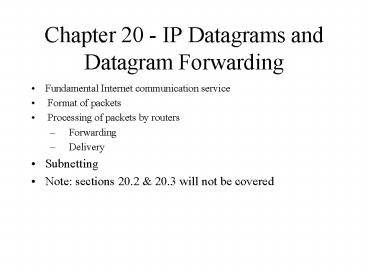Chapter 20 IP Datagrams and Datagram Forwarding - PowerPoint PPT Presentation
1 / 17
Title:
Chapter 20 IP Datagrams and Datagram Forwarding
Description:
Subnetting. Note: sections 20.2 & 20.3 will not be covered. IP datagram format ... Used for subnetting. Problem: Assigning 1 network number/ physical network ... – PowerPoint PPT presentation
Number of Views:78
Avg rating:3.0/5.0
Title: Chapter 20 IP Datagrams and Datagram Forwarding
1
Chapter 20 - IP Datagrams and Datagram Forwarding
- Fundamental Internet communication service
- Format of packets
- Processing of packets by routers
- Forwarding
- Delivery
- Subnetting
- Note sections 20.2 20.3 will not be covered
2
IP datagram format
- Formally, the unit of IP data delivery is called
a datagram - Includes header area and data area
- Datagrams can have different sizes
- Header area usually fixed (20 octets) but can
have options - Data area can contain between 1 octet and 65,535
octets (216 - 1) - Usually, data area much larger than header
3
Forwarding datagrams
- Header contains all information needed to deliver
datagram to destination computer - Destination address
- Source address
- Other delivery information
- Router examines header of each datagram and
forwards datagram along path to destination
4
Routing table
- For efficiency, information about forwarding is
stored in a routing table - Initialized at system initialization
- Must be updated as network topology
changes - Contains list of destination networks and next
hop for each destination
5
Routing tables and address masks
- Routing table kept small by listing destination
networks rather than hosts - In practice, additional information is kept in
routing table - Destination stored as network address
- Next hop stored as IP address of router
- Address mask defines how many bits of address are
in prefix - Prefix defines how much of address used
to identify network - E.g., class A mask is 255.0.0.0
- Used for subnetting
- Problem Assigning 1 network number/ physical
network - use up IP address space more quickly
- Solution introduce additional levels (subnet)
within an IP network - a network address (net ID), a subnet ID, and a
host ID.
6
Subnetting
Not subnetted A Network with Two Levels of
Hierarchy
7
Subnetting
Subnetted A Network with Three Levels of
Hierarchy
8
Addresses with and without Subnetting
9
Masking
Masking is a process that extracts the address of
a physical network from an IP address
10
Routing tables and address masks
11
Address masks
- To identify destination network,
- apply address mask to destination address
- compare to network address in routing table
- Choosing the Next hop
- Examining each entry in the routing table
- Can use Boolean and
- if ((Maski D) Destinationi)
forward to NextHopi - Example
- Consider a datagram destination address D
192.4.10.3 - examine entry 1
- 255.0.0.0 192.4.10.3 not equal 30.0.0.0 (fails)
- examine entry 2 3 both fail as well
- examine entry 4 255.255.255.0 192.4.10.3
192.4.10.0 - gt choose 128.1.0.9 as Nexthop
12
Forwarding, destination address and next-hop
- Destination address in IP datagram is always
ultimate destination - Router looks up next-hop address and forwards
datagram - Network interface layer takes two parameters
- IP datagram
- Next-hop address
- Next-hop address never appears in IP datagram
13
Best-effort delivery
- IP provides service equivalent to LAN
- Does not guarantee to prevent
- Duplicate datagrams
- Delayed or out-of-order delivery
- Corruption of data
- Datagram loss
- Reliable delivery provided by transport layer
14
IP datagram header format
15
IP datagram header fields
- VERS - version of IP (currently 4)
- H. LEN - header length (in units of 32 bits)
- SERVICE TYPE - sender's preference for low
latency, high reliability - (rarely used)
- TOTAL LENGTH - total octets in datagram
- IDENT, FLAGS, FRAGMENT OFFSET - used with
fragmentation (will be covered in chapter 19) - TTL - time to live decremented in each router
datagram discarded when TTL 0 - TYPE - type of protocol carried in datagram
e.g., TCP, UDP - HEADER CHECKSUM - 1s complement of 1s complement
sum - SOURCE, DEST IP ADDRESS - IP addresses of
original source and ultimate destination - IP OPTIONS (see next slide)
- PADDING add zeros to make header a multiple of
32bits
16
IP datagram options
- Several options can be added to IP header
- Source route
- Header with no options has H. LEN field value 5
data begins immediately after DESTINATION IP
ADDRESS - Options added between DESTINATION IP ADDRESS and
data in multiples of 32 bits - Header with 96 bits of options has H. LEN field
value 8
17
Summary
- Basic unit of delivery in TCP/IP is IP datagram
- Routers use destination address in IP datagram
header to determine next-hop - Forwarding information stored in routing table
- IP datagram header has 20 octets of fixed field
information and (possibly) options































